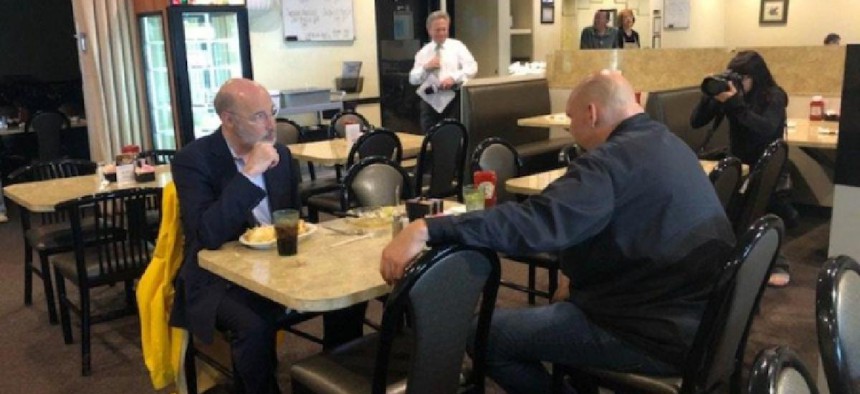Elections (Archived)
Primary portents for Pennsylvania's general election in November

Gov. Tom Wolf, left, meets with his new running mate, Democratic nominee for lieutenant governor John Fetterman, following Fetterman's win in Tuesday's primary. From Wolf's Twitter page
They call it a “primary” election for a reason – maybe a couple of reasons. One is its priority. It comes first, preceding the “general” election by about six months. More importantly, primaries separate the wannabes from the winners. Almost anyone can run in a primary but running in a general means you won that primary. That’s why the puny fraction of votes participating in most primaries have such an outsized influence on our politics. They decide whom we get to vote for in the fall election – and whom we don’t.
Here are five takeaways from Pennsylvania’s 2018 primary:
- Turnout was again abysmally low, ranging from the teens to 25 percent depending on the county – even with some of the most competitive and exciting races the state has seen in years. Since the vast majority of eligible voters didn’t vote, their choices in November will have been made by the minority that did vote.
- A Pennsylvania Referendum on President Trump was guaranteed by the results of the Republican primary nominating Scott Wagner and Lou Barletta for governor and U.S. Senate, respectively. Wagner, a bluntly hard-charging conservative, has modeled himself after Trump and his policies – while Barletta is a longtime Trump supporter who made his reputation as an immigration hardliner. Elections should be referendums; this year, they will be.
- Women candidates running in congressional races were enormously successful, bringing historic change to Pennsylvania, a state often loath to elect women. Statewide, eight women won nominations – seven Democrats and one Republican. In the Philadelphia suburbs, five of six women, mostly running as progressives, won their Democratic primary races. In most cases, these female candidates were a reaction to the Trump presidency, thus increasing the likelihood that the fall election will become a referendum on Trump. The present Pennsylvania congressional delegation has 18 men and no women. Tuesday’s results virtually guarantee that will change.
- Lou Barletta vs. Bob Casey is fated to a premier national U.S. Senate race in 2018. As a Trump supporter, Barletta is unique. He espoused Trumpian views before Trump himself did. As mayor of Hazelton, he gained national prominence confronting the federal government over immigration policy and went on to co-chair the Trump campaign in Pennsylvania. Barletta and Trump are joined at the hip on the issues, while Barletta’s opponent, Democratic incumbent US Sen. Bob Casey, is one of the Senate’s leading Trump critics.
- Political history was made when Braddock Mayor John Fetterman handily won the Democratic nod for lieutenant governor with a plurality of 38 percent, beating a field of four other candidates, including the scandal-mired incumbent Mike Stack. No incumbent lieutenant governor had ever previously lost a bid for reelection. Fetterman is a colorful progressive who received endorsements from Bernie Sanders and former Gov. Ed Rendell. He should increase turnout among Sanders’ Democratic followers in the fall. While some analysts wonder if there is even a need for the position, Gov. Tom Wolf may be happy voters have chosen Fetterman as his running mate.
Trump will not appear on another Pennsylvania ballot before 2020 at the earliest, but Tuesday’s results ensure he will be on the minds of many voters on Nov. 6. The results in the Republican primary, especially at the statewide level for governor and US Senator, will offer voters clear choices between strong supporters and equally strong opponents of the president. In addition, most observers agree this primary confirms the virtual takeover of the Pennsylvania Republican party by Trump supporters. Love him or hate him, Donald Trump now owns the Pennsylvania Republican Party – and the party owns him.
At the same time, the increasingly pervasive presence of progressives among winning Democratic candidates must be noted. Much ink has been spilled describing how (and why) the Republican Party has drifted so far right and toward the policies of the president. Less noticed but equally portentous is the steady leftward drift of Democrats. The ideological divergence between the two parties sets up often stark choices for voters. Some believe this is what modern democracy now needs.
In Pennsylvania, we will have to wait six months to find out if that is true.
Dr. G. Terry Madonna is Professor of Public Affairs at Franklin & Marshall College, and Dr. Michael Young is a speaker, pollster, author, and was Professor of Politics and Public Affairs at Penn State University. Madonna and Young encourage responses to the column and can be reached, respectively, at terry.madonna@fandm.edu and drmikelyoung@comcast.net.
